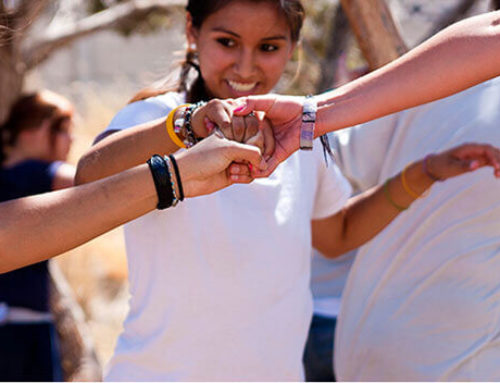When I first started working with special needs students I had what I was certain would be an easy assignment; play therapy with a class of six elementary school students. Yes, they had their struggles, but with such a tiny group, what could possibly go wrong? Plus, I was being paid to do something I was good at: playing.
It didn’t take long to learn the simple truth that you can’t make anybody (not even a cute eight year old kid) do anything they really don’t want to do. And there was a lot, it turned out, that these little folks didn’t want to do. I had one student pick up an aluminum baseball bat and clear everything off the classroom shelves because he didn’t want to do crafts that day.
Another climbed a tree with a pocketful of rocks, which he threw at anyone who approached. He was a good enough shot to keep us at bay and stay in the tree for several hours. Yet another student ran out of the classroom and across the street with me in pursuit. He pounded on the door of the first house he reached and, just as I caught up, told the man who opened the door that he didn’t know who I was and I was trying to kidnap him. The man believed him.
The more determined I became to gain and retain absolute control, the more serious I became and the more control eluded me. These kids were making a fool out of me and I didn’t like it. What was I going to do?
The answer, it turned out, was that I needed to beat them at their own game. They couldn’t make a fool out of me if I was a fool to begin with. So a few weeks into this stressful new job I decided to employ a powerful new tool, my sense of humor.
***
One day as I was teaching a unit about restaurant manners, an opportunity presented itself to employ my new therapeutic strategy. Jose walked into class thirty minutes late. Violating our first classroom rule, he did not take off his big down jacket when he sat down in his chair. He dropped into his seat with a thunk, crossed his arms and stared straight ahead with an angry frown. Whatever had happened at home that morning had clearly put him in a terrible mood.
“Jose, my friend, you know the drill. We hang our jackets up before sitting down.”
Jose just sat in silence, wordlessly challenging me. I turned back to the chalkboard and scribbled some more notes about “thank you,” “please,” and “chewing with your mouth closed.” When I turned back, Jose was still seated with his jacket on, glowering at me.
“We can all wait for as long as you need us to, Jose, but it would be a shame for everyone to miss recess,” I said. The other students immediately expressed their unhappiness, first by protesting to me “that’s not fair,” and then, when I remained unmoved, to Jose. Just hang up your jacket, Jose!” The peer pressure was too much for Jose. He got up, walked to the coat closet, and put his coat on a hanger. But instead of hanging the jacket in the closet, he marched up to me and hung the jacket on my pants pocket. Then he sat back down, crossed his arms, and gave me a defiant stare.
“Thank you, Jose,” I said, as if he had complied flawlessly. I continued with my lesson, pretending not to notice the jacket, exaggerating my movements so that it swung around me ridiculously. The class started to giggle and then to laugh. I could see Jose straining to force his face into a scowl, but after a while he couldn’t resist the hilarity. Soon, he was laughing as hard as anyone.
***
Humor is a magical confluence of timing, absurdity, and most of all, surprise. By definition, then, the best humor occurs when we least expect it, in situations that are tense, or serious, or important. There is a long, storied history of humor being used effectively in high-stakes situations to achieve a number of things, to break paralyzing tension, change the direction of a conversation, deliver otherwise unpalatable truths, cope with disaster, and etcetera.
Historical and literary records indicate that the role of court jesters, for instance, went far beyond eliciting royal giggles. Jesters were in a unique position to deliver difficult counsel–political and personal– in novel, surprising ways. The effect of this witty truth-telling was twofold: first, the jester could get away with delivering unsavory observations by coating it with the sweetness of humor; second, because the jester was communicating familiar advice in new ways (using riddles or wit) the king or queen was more likely to engage, hear, and understand the message.
Researchers studying human resilience have cited humor as a key tool for surviving extreme stress, such as that experienced by combat soldiers and POWs. Humor can be an effective coping mechanism during these situations because it breaks tension, disrupts negative thoughts and behaviors, creates a sense of situational perspective, and helps individuals retain a feeling of personal control (e.g. via defiance).
***
In a therapeutic setting, humor can have a similar function. Humor during individual and group therapy (whether generated by the therapist or the client) can lighten a mood, break a pattern, improve trust and sharing, create a sense of perspective, generate feelings of well-bring and hope, and provide an effective delivery system for difficult feedback. Family systems therapists will sometimes encourage family members to consciously employ a form of humor to interrupt entrenched relational patterns.
A therapist might, for instance, advise a client to do a silly dance the next time he finds himself in a familiar pattern of conflict with his wife. The silly dance is designed to interrupt a habitual pattern of hostility and break tension so that something can take the place of hostility. It’s hard to stay mad when faced with something ridiculous.
Humor is so powerful as a therapeutic tool, in fact, that there is a professional association dedicated to the study and use of humor in treatment. The Associate for Applied and Therapeutic Humor (AATH) defines therapeutic humor as “any intervention that promotes health and wellness by stimulating a playful discovery, expression or appreciation of the absurdity or incongruity of life’s situations. This intervention may enhance health or be used as a complementary treatment of illness to facilitate healing or coping, whether physical, emotional, cognitive, social or spiritual.
***
When faced with the serious issues that often drive family dysfunction, humor can seem out of place. But the next time you feel the urge to suppress a funny observation in the face of grave circumstances (or in the middle of family therapy), remember Abraham Lincoln’s wise counsel to his Civil War colleagues: “Gentlemen, why don’t you laugh? With the fearful strain that is upon me day and night, if I did not laugh I should die, and you need this medicine as much as I do.”
Then, go ahead and tell and you joke. It might be just what everyone needs.




